THE LANDSCAPING SOLUTIONS BLOG
Welcome to our Blog. Inspiration, updates and industry trends from the team at Landscaping Solutions.
PROS OF PERMACULTURE
Landscaping Solutions MD Ben West explains what permaculture is and its sustainability benefits.
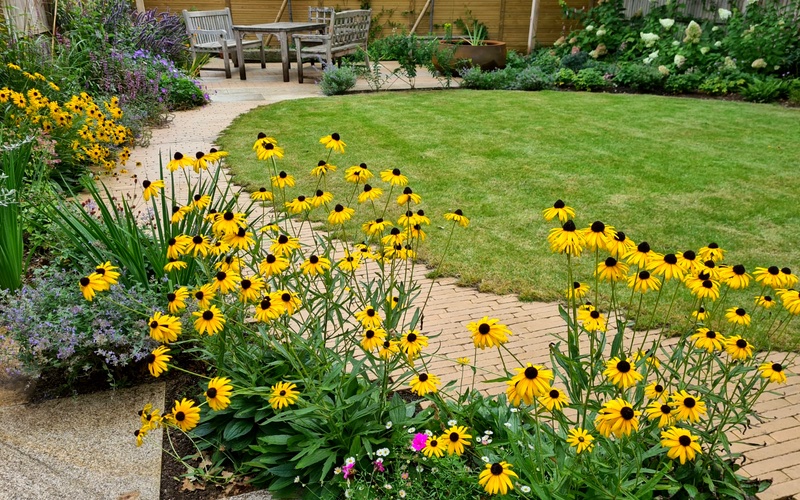
An example of permaculture garden design, built and maintained by Landscaping Solutions.
Last month I started to consider steps we might take, in lieu of top down leadership, to fashion solutions to the ‘sustainability problem’. Those in the industry looking to cut a path toward adopting fully regenerative practices have a ready sharpened tool in the form of ‘permaculture’, a system that can be applied to garden design as well as every other aspect of our lives. Permaculture design offers guidelines by which we can operate sustainably on a personal level and positively influence the actions of our clients.
Permaculture recognises the sustainability problem is rooted in the prevalence of economic models which overlook diverse, traditional and local operations in favour of monolithic global systems dependent on mass consumption of fossil fuels and resulting in cultural and environmental degradation. Permaculture eschews the global model and works to preserve and enhance the best of the existent. In short, it is the design of sustainable human habitats.
Australians Bill Mollison and David Holmgren introduced the concept with their 1978 book ‘Permaculture One’. They saw the current economic system as flawed and took inspiration from the propensity of natural ecosystems toward rejuvenation. Permaculture design closely observes nature, notes the connections between its manifold elements and uses these relationships to inform its work. It is opposed to the myth of separation and the harmful ‘survival of the fittest’ concept of nature in favour of a view of the natural world as a host of symbiotic relationships and interconnected ecosystems.
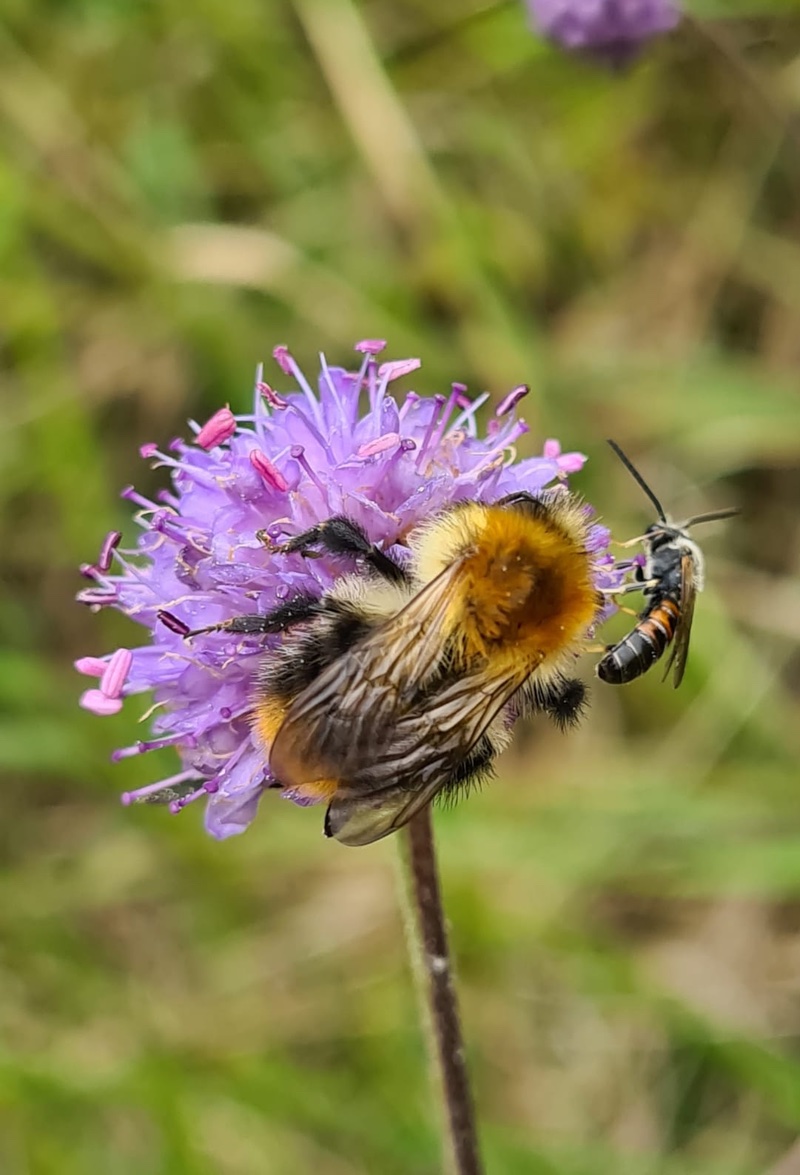
The difference between ‘standard’ garden or landscape design and permaculture design lies with the lens through which the decision making process is viewed - permaculture ethics. Simply stated, these are: Earth care, people care and fair shares. These principles inform all design choices. Earth care acknowledges our dependence on a healthy planet for survival and advocates its veneration and conservation. People care recognises the physical and emotional needs of modern humanity, and looks to utilise technology and intelligent design to avoid problems that made formerly sustainable modes of living untenable. Fair shares asserts the finite nature of the Earth, the need to establish limits to human consumption and balanced distributions of ‘wealth’.
Much modern garden and landscape design revolves around making things pretty rather than useful. Many plans please the eye but lack technical detail or practical function. We should not reject the aesthetic; rather, this aspect should flow naturally from a meticulously researched and beautifully realised design. Permaculture is all about the details.
This pragmatism is evident in the key concepts of ‘zones’ and ‘sectors’. Zoning brings elements requiring most attention closest to centres of human activity; vegetables and fruit close to the kitchen, for example. Less frequented areas are set aside for lower maintenance features. Sectoring considers the influence of exterior factors such as wind, rainfall, light, views, local flora, fauna and architecture, and incorporates these into the design to create beneficial connections between the elements. The needs of one are met by the outputs of another; soft vegetative prunings become mulch via the compost heap, for example. Each element performs multiple functions thus maximising the overall efficiency of the whole. The aim is to form a ‘closed system’ in which energy, nutrients and resources are recycled rather than lost. Like a natural ecosystem, nothing goes to waste and everything has value.
In order to achieve our regenerative goals, we must work wisely with what we have rather than expend valuable energy in a protracted and dysfunctional struggle to bend nature to our will.
Visit www.permaculture.org.uk for further information and feel free do drop us a line with your thoughts and feedback on Ben’s article at info@landscapingsolutionsltd.co.uk.
SUSTAINABLE GARDEN DESIGN - THE FUTURE OF LANDSCAPING
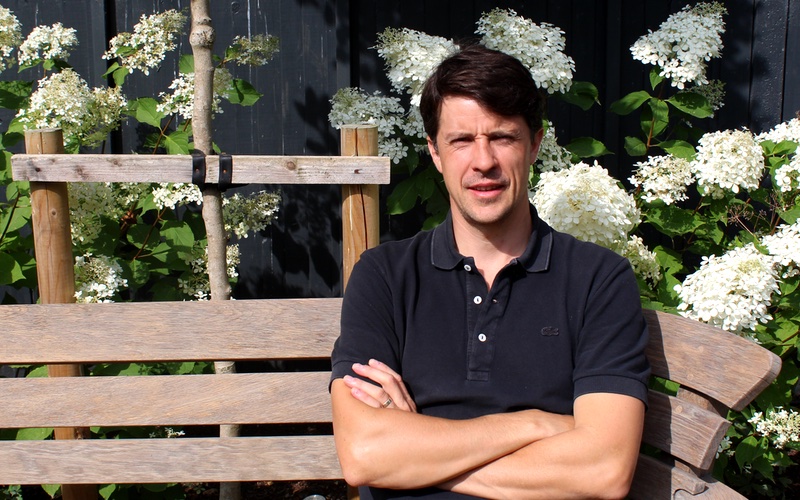
Ben West, Landscaping Solutions.
Garden designers and landscapers are in a unique position. We not only build gardens but bring an enormous pool of knowledge that influences the materials used, the plants chosen…and the wildlife that will visit them.
We’ll all take our own lessons from these lockdown weeks, but one of the precious things that they’ve given, rather than taken away from us, is time to think, to reassess and to create intent.
One of the most prevalent shared experiences of these weeks seems to be a greater appreciation of Nature, of its therapeutic value and how much we miss it when we cannot access it. Birdsong has become more noticeable, the air clearer. Butterflies seem more plentiful in the gorgeous weather.
Here in South West London, I’d venture that the leaves look a brighter green because of the lack of pollution.
Last year, the summit meeting at Futurescape concentrated on how the landscape industry might address climate change and I was on the podium as part of the discussion panel. When I looked around the meeting room, I saw impassioned and informed individuals seeking unity on the subject and itching for more progress within the industry.
It’s a matter that has been close to my heart for a long time. At Landscaping Solutions we began to increase the sustainability of the business some time ago. Seemingly small actions mount up to a much larger overall impact. But we believe there needs to be a more unified approach across the landscaping world.
Sustainability begins at ground level, before a spade is lifted. Putting it at the very beginning of a garden design project opens the opportunity for dialogue-rather than deciding on a material and us looking for a way to increase its sustainability through the supply chain or installation methods, it offers the chance to discuss materials and methods that the home-owner might not know to specify but which fulfil the brief.
Regenerative designs-those which add to the environment, rather than take away-are far more realistic, achievable and cost-effective for the average garden-owner than the slightly sterile designs that are so often to the fore in show gardens and which have such influence. We hope that trend-setters in the landscaping industry will push hard to move away from the unsustainable schemes that have been in vogue for so long.
This is an exciting time, full of hope. The Futurescape event made clear the hunger that members of the industry have for a different approach. There are designers around the country who put deep thought into how to make projects more sustainable, whether finding required stone onsite, using suppliers who propagate plants using peat-free compost, getting rid of waste products on Freecycle instead of sending them to the tip. There are many small steps that incrementally make a big difference, especially across an entire industry.
Here at Landscaping Solutions, we’re in the process of adding to our sustainability measures. Already, in sharing our knowledge of how to make gardens more attractive to wildlife, even with very small, easy-to-manage additions, we encourage garden-owners to widen the possibilities and create habitat that will sustain insect-life and the birds that feed on them.
For the future, we are looking to integrate an ecological assessment for each design and build. We’re examining ways to make the business zero-carbon or, at least, carbon neutral. We’re looking into the opportunities afforded by permaculture design. Can we create a suppliers’ carbon register, letting us align ourselves with suppliers with a good environmental approach? The possibilities are much wider than might immediately appear and many more ideas are under consideration.
What this means to home-owners is that they will know that their garden is not only contributing to the well-being of wildlife, giving their outdoor space an additional element to enjoy, but has made the least impact possible during its creation. It doesn’t have to mean a high-maintenance garden: minimising the necessity for power-driven maintenance tools is also a factor in the sustainable garden design.
For garden designers interested in working this way, Landscaping Solutions offers a sympathetic, enthusiastic partnership: solving problems, sharing knowledge, co-operating on plants and materials in a shared ethos, with no loss of quality or attention to detail in the build itself.
These lockdown weeks have given much food for thought to everyone, about our own lives, our working practices, the importance of personal contact, community and friends. In the context of gardens, they’ve shown us just how much we need a natural environment to recharge our batteries, to enjoy better health, to find serenity.
Now is the time to plan to act on this understanding. At Landscaping Solutions, we build award-winning gardens. We also want to build a better environment for us and our children.
We look forward to the exciting opportunities afforded by working with like-minded designers and suppliers. If you’d like to discuss the opportunities for your garden design, contact us at Landscaping Solutions now.
AN AWARD-WINNING GARDEN DESIGN ENHANCES YOUR HOME
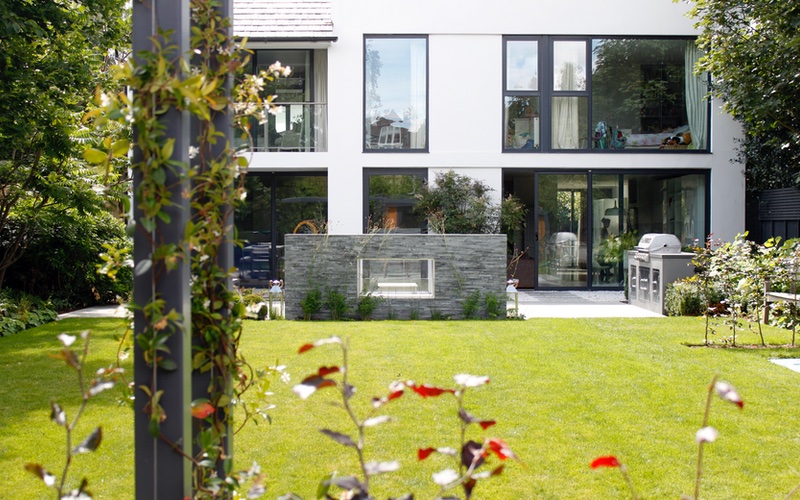
The design by Cassandra Crouch meant that the garden and house felt right together.
At Landscaping Solutions we work with some of the leading garden designers in the UK. We regard our role as providing a safe pair of hands when it comes to delivering the design, taking worry off the shoulders of both garden designer and householder. This is exactly what we did for Cassandra Crouch with this beautiful space on the edge of Richmond Park, South West London.
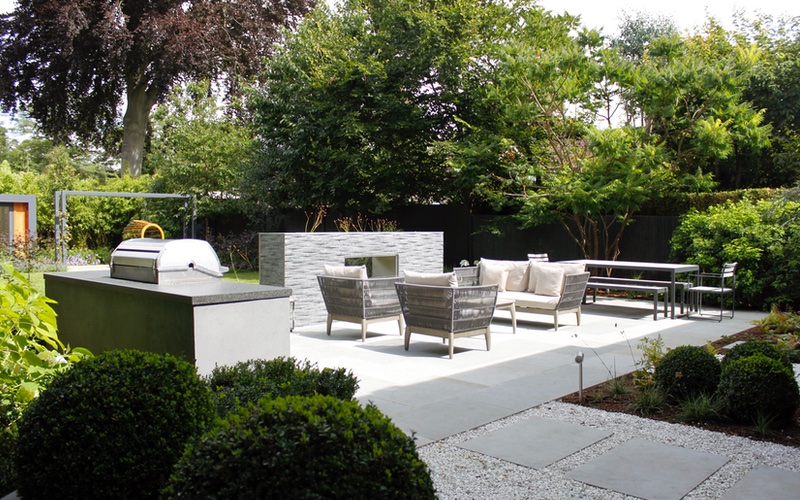
BALI award-winning garden, in South West London, designed by Cassandra Crouch.
Typical of family gardens, this one had a wide-ranging brief. It needed areas for:
- adult exercise and children’s play
- entertaining and outdoor cooking, during the day and after dark
- for rest and relaxation
- for storage
And while the clients were not particularly keen on gardening, they did want a variety of heights and textures in the planting to create year-round interest.
The house has a rectilinear, minimalist feel, and Cassandra’s design gives it a strong sense of place with the use and overlap of strong squares and rectangles in the design - even the trampoline is square. Cassandra’s Crouch’s design marries the garden to the building, creating a relaxing space that feels right at home.
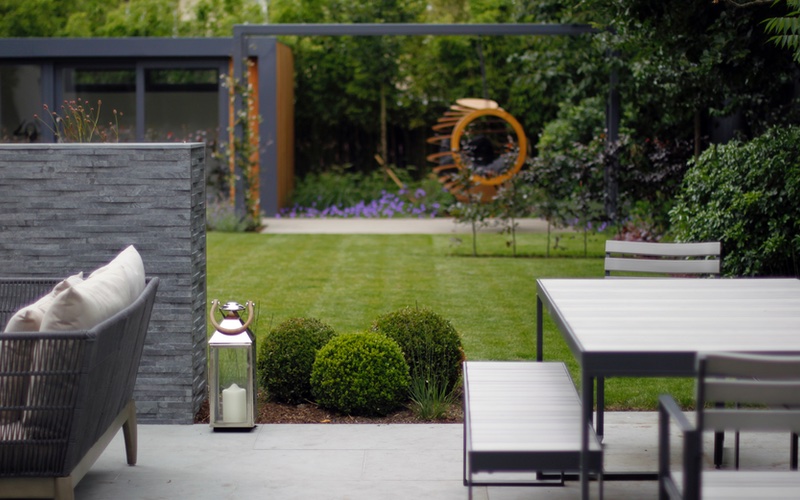
Beams made by Leighton Ironcraft support a hanging seat that offers a contrasting shape to the lines and rectangles.
Generous beams support the hanging seat; grassed and paved areas have straight edges and ninety-degree angles on their corners; the fireplace feature and barbecue are strongly rectangular.
A design like this needs a highly accurate finish - imperfections in angles and straight lines are immediately visible. At the same time, the variety of materials requires skill and experience to integrate them seamlessly, as well as very careful attention to detail to ensure that levels match and surfaces move smoothly from one texture to another.
We pride ourselves at Landscaping Solutions on creating a luxury finish. “They are passionate about construction,” says Cassandra, “and strive to achieve very high standards.”
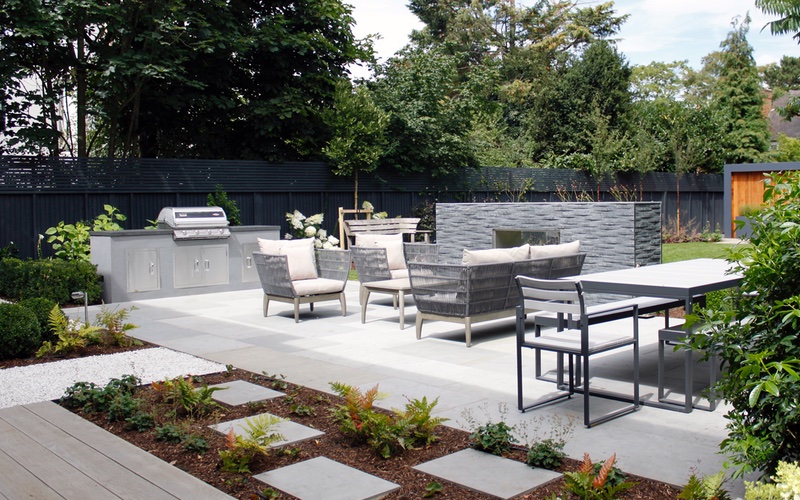
Sawn Grey Yorkstone and Smoked Oak Millboard combine textures in this garden designed by Cassandra Crouch in South West London.
High-quality materials completed the sense of luxury. The patio uses Sawn Grey Yorkstone (supplied by London Stone) which tones beautifully with Millboard’s Enhanced Grain Smoked Oak composite decking, laid at the access to the house and around the gym/studio, while adding contrasting texture.
This was a garden design that required a wide range of landscaping skills. As well as laying different materials and recycling existing paving to allow access to a storage area hidden behind the gym, we installed textured tile cladding and stainless steel beading to the fireplace, put in the barbecue and then rendered and painted its housing to tone with the overall colour scheme. Light-coloured aggregate around paving stones was retained in a stabilising system to prevent gravel migrating to beds and paving and to make a stable surface to walk on.
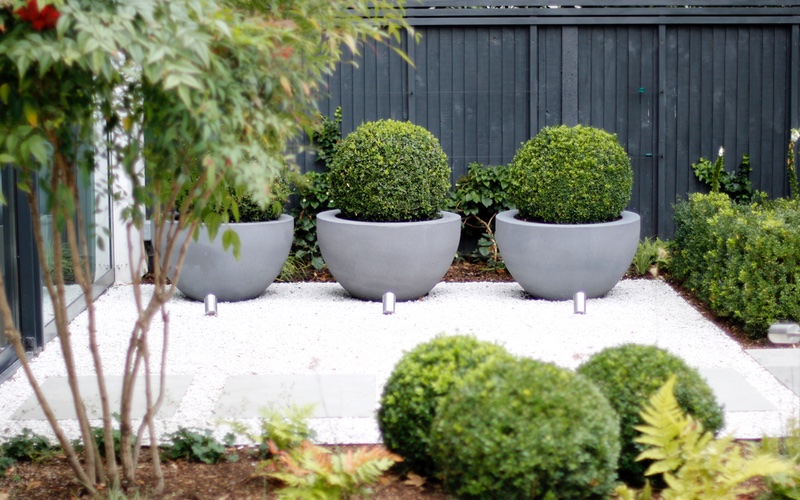
Round box balls, uplit at night, add contrasting shape and texture in a garden which the owners wanted to be easy to look after.
Lighting, which picks out shape and texture at night and focuses on the barbecue and seating area for extended evening use, was installed by Electrosafe Landscape Lighting Ltd, overseen by us at Landscaping Solutions. The drip-irrigation system, which we installed, will reduce work in the garden and ensure the survival of plants while the home-owner is on holiday.
Badgers!
So far, so normal for our teams at Landscaping Solutions. However, this build introduced an interesting additional element - badgers in a neighbouring garden.
Badgers are protected by law, as are their setts, and if works needs to be done in their vicinity, a licence is required from Natural England.
Landscaping Solutions happily shouldered the responsibility of ensuring everything was done as it should be. Natural England required the installation of night cameras to monitor sett entrances for two weeks. With no badger activity recorded, work could progress.
“I was really pleased to have had the challenge,” says Landscaping Solutions’ Ben West. “It means we learned best practice for the situation and allowed me to get up close and personal with one of my favourite British mammals. I’ve been badger-watching since I was a young lad so it was second nature for me to want to do the best by the badgers.”
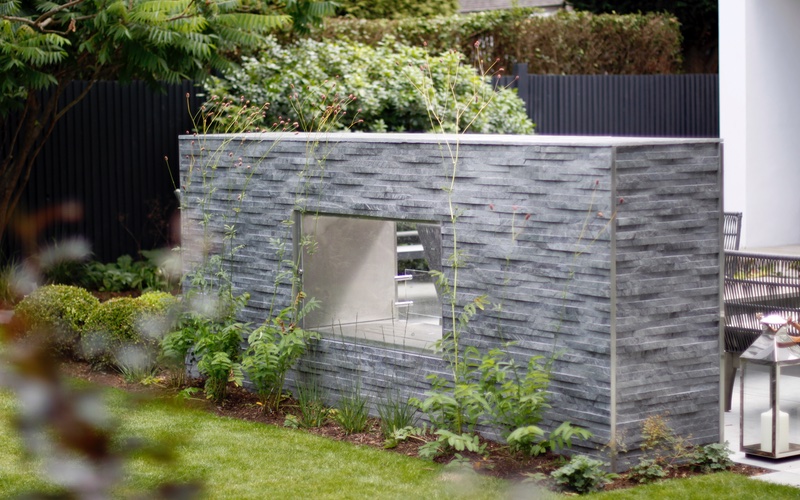
Textured tiles clad the outdoor fireplace with stainless steel beading to finish the edges.
In the meantime we shifted our schedule to make progress in other areas of the garden, away from the badger area. Good communication with garden designer Cassandra Crouch and the homeowners meant we could be flexible in our approach and work out an efficient reorganisation of the sequence of jobs required.
We completed the build in a couple of months, in June 2016. It went on to win us our fourth BALI award, and our second Principal Award, this time in the category of Domestic Garden Construction (£60K-£100K).
“The team are professional and pleasant to work with,” said Cassandra. “Both the client and myself are extremely happy with the result. I would not hesitate to recommend them to clients in the future.”
See our other award-winning gardens.
Contact Ben West to find out how we can help you create a luxury garden to the highest standards for your clients. If you’re a home-owner looking to enhance your living space, we can refer you to talented garden designers. Just get in touch to discuss.
NATURE-FRIENDLY GARDEN DESIGN A SPECIALITY
Do you secretly long for a more Nature-friendly garden but fear the work involved? If you’re a garden designer, do you struggle to inject Nature-friendly elements into a brief because of clients fear it will result in an unwelcome workload?
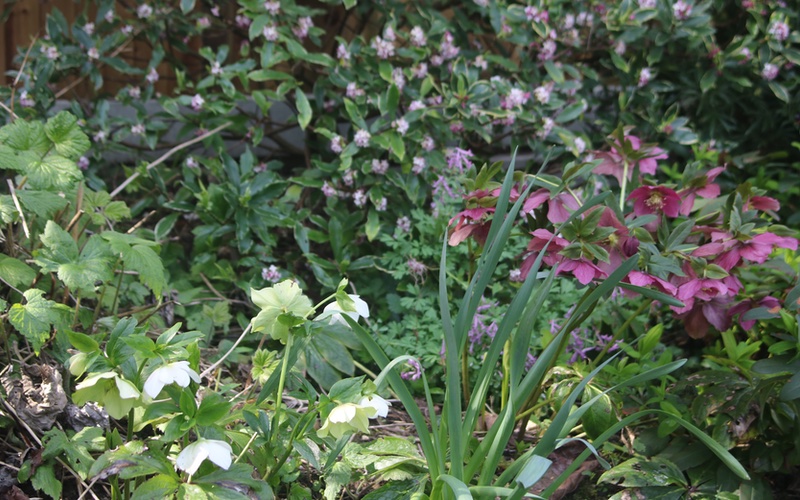
A low-maintenance corner of easy-care shrubs and perennials like the scented daphne (in background) and the hellebores in the foreground offer sustenance to insects early in the year. (Picture: Helen Gazeley)
Gardens are many things: a place to relax, to entertain, a play area for the kids, a haven, perhaps just somewhere for the cats to laze in the sun. Whatever it is, it certainly shouldn’t be a burden.
A garden is also where the natural world comes closest to our lives.
If we allow it to.
Garden-design briefs often veer towards pushing Nature away. Even as the merits of trees and plants in controlling pollution and producing cooling effects, the advantages of wildlife corridors across cities, and the physical and mental health benefits of looking out at a natural scene are increasingly understood and extolled, we lay more artificial grass, cut down trees, and even pave over entire gardens, generally in the interests of Low Maintenance.
Mea culpa!
The Outdoor Room
In part, it is the landscaping industry’s fault. We have spent the last two decades, since Groundforce took TV viewers by storm in the 1990s, describing the garden as an outdoor room, making it out to be an extension of our living space. And while we can certainly extend our day-to-day living into the garden, it is most certainly not a room.
What has been the effect of calling a garden an outdoor room? We suggest that it’s subtly altered expectations, and had a major impact on the look of gardens over the subsequent decades. If the garden is another room, it should look pretty much the same all year round and, if it’s a room, then all it needs is a quick dust, Hoover and tidy-up every so often, just like the lounge indoors.
In many ways this is ideal. Low maintenance is understandably one of the most frequent demands for a garden design, with mowing, weeding, leaf-blowing and pruning kept to an absolute minimum.
But what is missing?
Benefits of a Nature-friendly garden
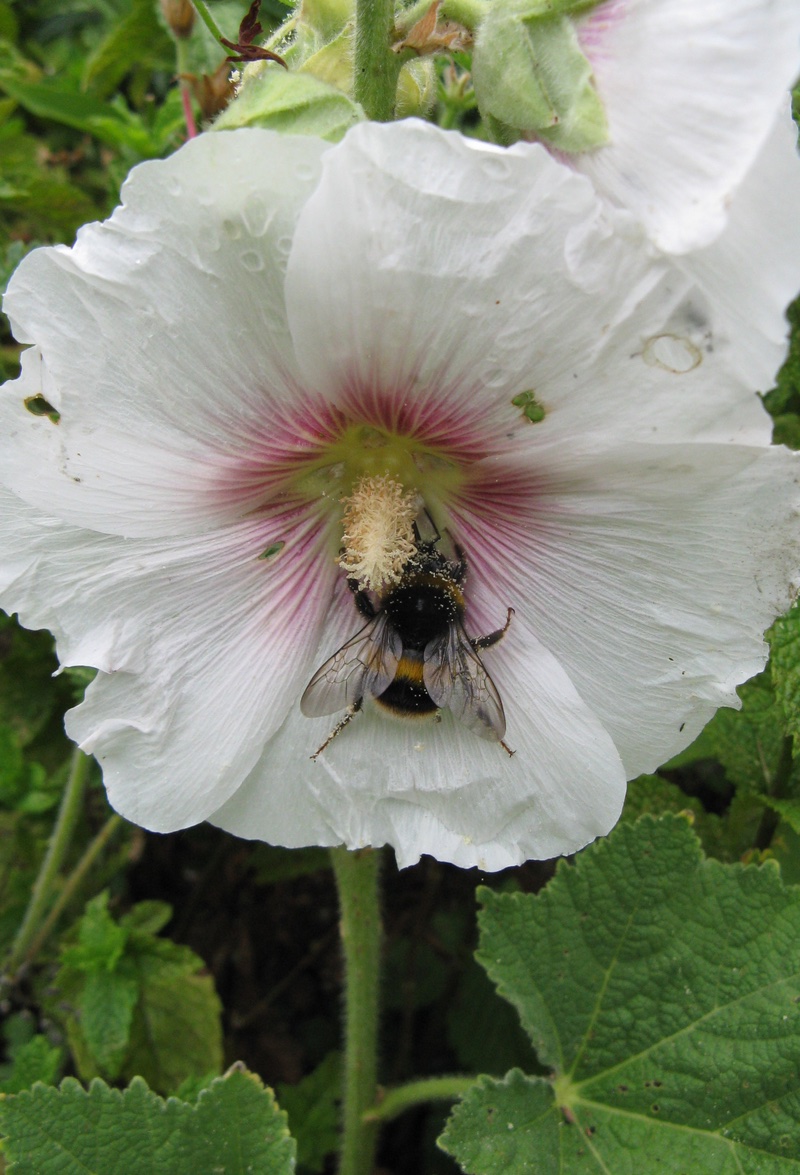
A single flower gives bees the chance to collect pollen where double flower sometimes don't. (Picture: Helen Gazeley)
A nature challenge run by The Wildlife Trusts in 2015 asked participants to do one “wild” activity every day for a month. Participants reported at intervals on how they felt. It turned out that even simple activities like feeding the birds and planting bee-friendly flowers made a difference, with an increase of 30% in participants reporting themselves in excellent health at the end of the challenge.
Other research has demonstrated how a view of nature reduces the need for pain-killers, aids healing, rests the mind and reduces negative emotions.
Children gain enormously from interaction with the natural world. In fact, research into human development portrays childhood as a time when we particularly want to explore it.
And none of the above is possible without the building blocks of a Nature-friendly garden that will attract the wildlife to give you the restorative and stimulating environment that will make a haven for you and a playground for your children.
The landscaping industry’s role?
At Landscaping Solutions we believe that we all have a responsibility towards Nature.
We feel privileged to be part of an industry which is uniquely placed as a bridge between the needs of our clients and the natural world. We can distance people from Nature, or we can create a manageable environment which harmonises with Nature.
If we look after it, it will repay us, with all the benefits listed above.
Client-friendly AND Nature-friendly
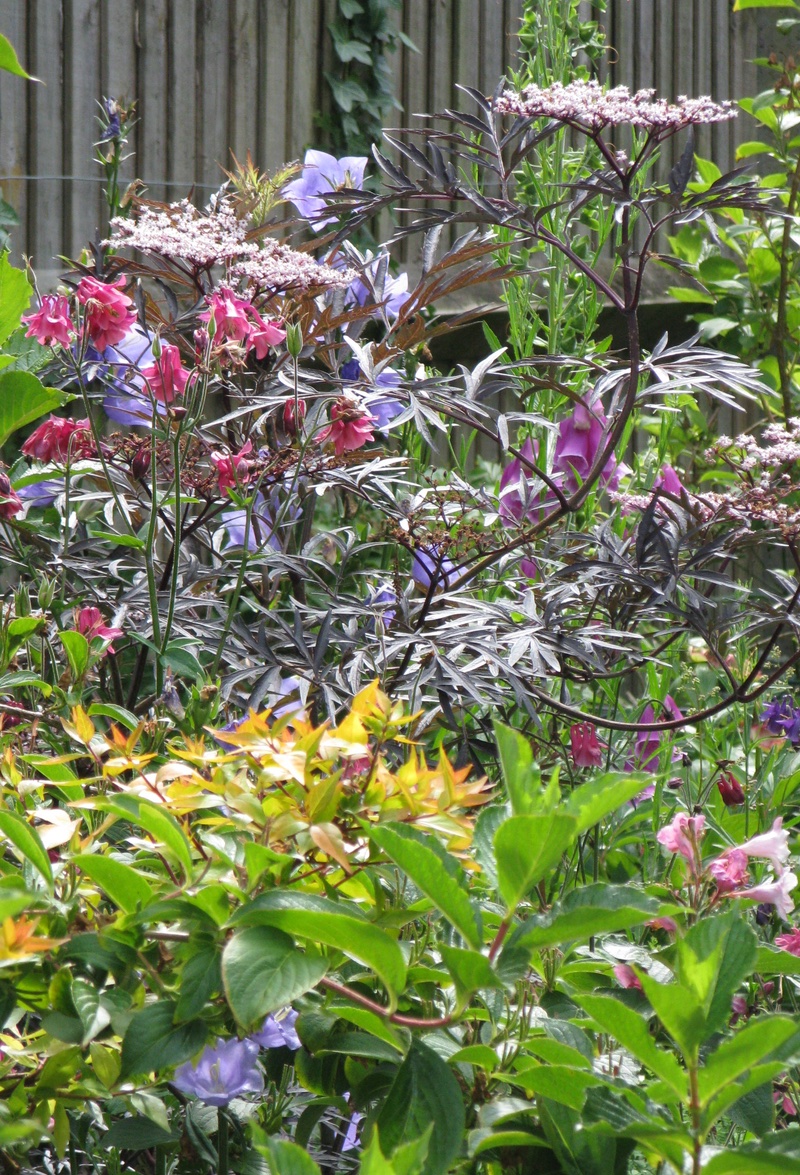
A mix of summer shrubs and self-seeders creates a nectar-rich corner. (Picture: Helen Gazeley)
What does this mean for your garden or, as a designer, your clients’ garden? At Landscaping Solutions, we’re not advocating creating a wilderness outside the back door. We have built award-winning gardens that major on high-quality hard landscaping, with very formal designs and minimalist planting. We’re not going to preach about what should and should be in your or your clients’ garden. However, we choose our materials and plants mindfully.
And this is where we can help. Most garden-design briefs allow plenty of room for nature-friendly elements creating regenerative garden designs that add too, rather than take away from, the environment. They may not be things that you immediately associate with a low-maintenance garden but, if properly installed, they require little attention while enhancing the design, bringing the pleasures of Nature closer to your window, and making a more sustainable design for local flora and fauna.
Here at Landscaping Solutions we have an excellent understanding of how to introduce tiny differences with a big impact, adding a Natural element and yet give you a living space that you can use as part of your daily life and not slave over.

Ivy makes an ideal, easy-to-trim fedge (mix of hedge and fence) and strikingly structural fruit which feeds thrushes in winter. (Picture: Helen Gazeley.)
From choice of productive shrubs, trees and nectar-rich flowering plants that will attract and feed wildlife, choice of grasses and wildflowers for the lawn and minimum grass-cutting regimes, to the installation of safe ponds and small areas of locally appropriate habitat, we have plenty of tools in our toolbox to create a design that will give you an interesting, sustainable garden throughout the year.
We work sympathetically with designers who want to expand the Nature-friendly extent of designs. We can also provide a garden design service. Alternatively, if you would like to make some changes, however small, to your existing garden with a view to supporting wildlife and are wondering what you could reasonably do, we’re happy to advise.
For more information or an informal chat about options, contact Ben West.
STOP PRESS:
At Futurescape on 19th November, Landscaping Solutions’ Ben West will be taking part in the Summit at the end of the day.
A leading industry event, taking place at Sandown Park Racecourse, Surrey, Futurescape brings designers, landscapers and contractors together from all over the UK, creating a stimulating platform for industry debate. Ben will be asking exactly what are our responsibilities as an industry in creating outdoor spaces, and how can we reasonably fulfil them?